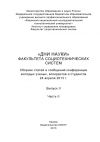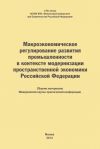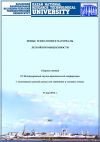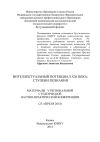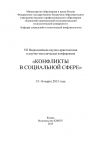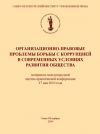
Автор книги: Коллектив Авторов
Жанр: Прочая образовательная литература, Наука и Образование
сообщить о неприемлемом содержимом
Текущая страница: 1 (всего у книги 10 страниц) [доступный отрывок для чтения: 3 страниц]
Молодёжь о проблемах изучения иностранных языков в современном мире. Сборник Международной научно-практической конференции студентов, аспирантов и молодых ученых
PERSONAL EXPERIENCE OF LEARNING ENGLISH AND FRENCH
УДК 81-13:[811.111+81.113.1]
ALMETOVA A.
University of Toronto, Canada
When I was a 17 year-old girl, I went to the UK to study the International Baccalaureate program. Prior to that, I had been learning English and French off and on for a few years. In the UK I studied 6 subjects for the two years and obtained my IB diploma in order to enter a university. The course was extremely tough, I had many difficulties with all of my subjects, but it was possible for me to overcome the difficulties.
From the very beginning of the course I realized that the first problems came to me due to the lack of terminology I knew for the subjects. I had to catch up a lot in my biology, economics and even math courses. I worked really hard, asked as many questions as I could, I was learning every day, I could not imagine myself at a lesson without a dictionary. In order to understand and learn each subject I needed to find the logic inside it. Basically, I did not need to learn by heart, but I needed to learn what the IB system wanted me to learn. Moreover, I read newspaper articles every day. The main aim for me was to learn how to think in English.
In my IB diploma I also studied French literature. Our professor used many different methods of teaching. We had debates on specific topics, were listening to the CDs, had oral exams and were writing essays. Throughout the course we read 4 books and wrote our final work on one of them. All in all, my comprehension of French has improved a lot with the help of all the learning methods. This year I realized that at the French lectures and Tutorials I really started thinking in French.
At the moment I am studying in Canada, where I have an opportunity to practice both of the languages. I know that my English and French are not perfect, but in comparison to the previous years I’ve made some progress.
In order to learn a language, it is important to use books, learn specific vocabulary in science, social science, humanities, according to the personal interests. It is useful to prepare oral presentations in different topics and organize debates. At the university, we practice speaking a lot. We have specific lessons called Practical where we talk with everyone in the group and learn grammar. Every two weeks we write small tests. I really like it, because with the help of regular tests I memorize better.
In my opinion, the system of learning any language should contain a variety of tasks. If something is difficult to memorize, try to make it as simple as possible. Moreover, apply your knowledge into real tasks.
And one last remark. The more languages you are trying to learn, the easier and the more pleasant it is to master the next one. As for me, I have started studying Italian as a third foreign language and I am definitely enjoying it and really into it.
ECONOMIC PROBLEMS OF THE EUROPEAN UNION: THE FEATURES OF HARMONIZATION AND UNIFICATION OF THE TAX SYSTEMS OF THE EUROPEAN UNION COUNTRIES
УДК 336.221.4:061.1EC=111
ANISIMOVA V.
Ufa State University of Economics and Service (Ufa)
Development of the world economy causes the output of the productive forces and production factors beyond the nation-state. There is a lot of freedom for migration of all elements of economic activity: capital, labor, and finance. With the globalization of today's economy and the development of integration processes the harmonization of tax systems becomes a first priority problem.
The harmonization of tax systems is the systematization and standardization of tax systems and tax policies of the countries of the international community. It is especially important during the world financial crisis [1].
The most obvious manifestation of internationalization and the growing interdependence of the economies of the states is the economic integration within the European Union. Harmonization and unification of the tax systems of the countries – members of the European Union has become a powerful tool to ensure the integration process within the European Union. According to the Treaty establishing the European Union, which entered into force in 1958, sales tax (VAT) and other indirect taxes are subjects to unification. Within the European Union, the value added tax has become an important tool in the fight for markets against other countries, particularly the United States [2].
Tax harmonization suggests creating areas with a unitary tax system. At the same time, all countries should always adhere to the following basic principles developed by the Member States of the European Union:
The tax policy of the state is to ensure freedom of promotion of goods and people;
The national tax policy should not be in conflict with the tax policies of the other countries;
Tax policy should prevent double taxation.
The tax harmonization in the European Union has set itself such purposes as:
The abolition of the tax limits in order to ensure equal competitive conditions for businesses;
The integration and unification of the European Union internal market as the main engine of integration processes in the region;
Bringing the tax systems to conformity [3].
The experience of the European Union member states showed that the system of indirect taxes is more a subject to harmonization, as they have the greatest impact on mutual trade, pricing goods, and account for a large share of tax revenues in the budgets of all European Union states. It should be noted that in the development of mutual trade, the procedure for collecting VAT is of considerable importance. Currently, all countries of the European Union have turned into a «country of destination», which provides a zero rate of VAT on exports of goods (works and services) and the VAT refund from the budget on the resources used for exported goods. The experience shows that some defects made in the tax laws on VAT indicate the presence of double taxation. The fact is that neither the Agreement nor the national legislation of the countries clearly define the concept of export of services and activities. The result is a situation where the work and services sold by a non-resident are taxed both in the country of origin and the country of destination. To eliminate this negative practice, it is necessary to develop a single list of exported and imported works and services, as well as a uniform tax system. One of the important problems of overcoming obstacles appeared during the process of harmonization of tax systems in the European Union is to harmonize the profit tax systems [2].
Currently, all countries of the European Union are in the process of reforming the tax laws. The practice shows that the tax legislation is developing in the direction of harmonization, as only in these conditions it is possible to allow equal competitive conditions and free flow of capital, goods, services, labor.
References
1. European Problems// p. 2-3. Source: http://www.grin.com/en/ebook/118279/european-problems-challenges-of-the-european-union
2. Дивиденко Я.А. Особенности процессов гармонизации и унификации налоговых систем стран Евросоюза. стр 4-5.
3. Wikipedia// Harmonization of law. Source: http://en.wikipedia.org/wiki/Harmonisation_of_law
LINGUISTIC AND CULTURAL FEATURES OF “NURSERY RHYMES”: BIOMORPHIC CODE
УДК 801.81
BAGDASAROVA C.
Tver State University (Tver)
The collection of poems and verses for children under the title “Nursery Rhymes” reflects the unique English linguacultural society. Almost each poem includes specific lexical items that indicate typical and culturally colored options, many of which are associated with certain archetypes.
Due to the basic codes of culture [1], in the collection “Nursery Rhymes” biomorphic code is nationally specific. Under this code different creatures that inhabit the world are understood. The following poem reflects the features characteristic of the English culture of the 17-19th centuries. A good wife and housewife is compared with a caring hen.
I had a little hen,
The prettiest ever seen;
She washed up the dishes,
And kept the house clean.
She went to the mill
To fetch me some flour,
And always got home
In less than an hour
She baked me my bread,
She brewed me my ale,
She sat by the fire
And told a fine tale
The analysis of the poems from the book «Nursery Rhymes» shows that animals and plants as the parts of the biomorphic code have got nationally specific meaning and are used within the so-called historical subtext. The biomorphic code is represented by 125 items.
If we follow the classification of the realias [2], the biomorphic code of the English children’s folklore can be divided into two categories. We are speaking about geographic and ethnographic realities and their temporary subdivision. The poem about Robin Redbreast, i.e. a robin with a red breast, includes implicit references to the legend of how the robin’s tail changed its colour from light brown to red. The bird wished to ease the suffering of Jesus Christ, so it sat on the cross and began to sing while drops of Christ's blood were watering his feathers.
Little Robin Redbreast sat upon a tree,
Up went pussy cat, and down went he;
Down came pussy, and away Robin ran;
Says little Robin Redbreast, Catch me if you can.
Little Robin Redbreast jumped upon a wall,
Pussy cat jumped after him, and almost got a fall;
Little Robin chirped and sang, and what did pussy say?
Pussy cat said, Mew, and Robin flew away.
The options of these codes are similar in English and Russian languages, but the cultural myths are different. For example, the English connect the bird’s red breast with the red uniform of the British postmen, who are called “robins” because of uniforms’ bright color. In the 19th century the picture of a robin-postman was printed on postage stamps and Christmas cards. In Russia a postman, who delivers the Christmas and New Year greetings, is traditionally represented by a bullfinch.
Interpreters should look for the necessary language means to represent differences in the cultural biomorphic codes.
References
1. Krasnykh V.V.: Etnopsikholingvistika i lingvokul'turologiya: Kurs lektsiy. – M.: ITDGK «Gnozis», 2002. – 284 s.
2. Florin S., Vlakhov S. Neperevodimoye v perevode. – M.: Izdatel'stvo «Mezhduna-rodnyye otnosheniya», 1980. – 341 s.
3. Stikhi Matushki Gusyni: Sbornik / Na angl. i russk. yaz. – M.: OAO Izdatel'stvo «Raduga», 2003. – 384 s.
INTERCULTURAL COMMUNICATIONS AND TRANSLATING FROM ENGLISH INTO NON-ENGLISH LANGUAGES
УДК 81-22
BAKIROVA A.
Ufa State University of Economics and Service (Ufa)
Intercultural communications relates to cultural competence. Interacting with people of different backgrounds is important in the modern day world and understanding the cultural context, background, and upbringing of the people around you, can allow a better relationship to develop.
Intercultural communication is laden with difficulties. Even with the progressive globalization of the modern world, language continues to be a barrier to effective communication. If you have ever studied a foreign language or spoken with someone for whom English is a second language, you are aware that many speech patterns and common expressions simply do not translate well. Although nonverbal intercultural communication is less frequently explored, it is still extremely important. From hand gestures to bowing, nonverbal communication is crucial in every culture. Understanding the common issues associated with intercultural communication can lead to more effective communication with people from different cultures.
Knowing how to speak two languages is not the same thing as knowing how to translate. Translation is a special skill that professionals work hard to develop.
When an advanced translator takes on a job they keep in mind the numerous aspects that go beyond simply translating the literal English translation. These aspects include:
• Cultural nuances
• Document structure
• Context
• Composition
• Accurate dialect/colloquialism
• Understood target audience
Why is English Translation Difficult?
There are several, unique aspects of the English language that cause English translation into another language to be quite challenging. One of these difficulties includes the verb-adverb concept that is distinct to English. This concept includes combinations like “turn on,” “turn off,” “mark up,” or “mark down.” It can be quite difficult for translators to reflect this as other languages only use single specific verbs instead of the English verb-adverb combinations.
Another reason English translation into another language is so difficult is because of how English incorporates articles. Even though nearly every Western European languages use articles, a significant amount of other languages do not.
English Translation to Spanish Translation.
In the translation process, a significant detail a translator must take into account is the target market. This is especially critical when it comes to Spanish translations, since there are so many countries and cultures where it is spoken with subtle differences.
Despite the fact that some say there is a universal Spanish language that can be attained by using general terminology (understood in most regions), it is known that each country or region has its own colloquialism, unique expressions, ways of addressing people, and ways of using tenses.
This is undoubtedly the chief feature that should be kept in mind when translating an English translation into Spanish. Translating for a market in Spain is vastly different than translating for a market in Argentina, Mexico or the Spanishspeaking community in the US.
English Translation of Proverbs.
Proverbs, clichés and idioms are a notable examples that displays the process and complexities of English translation. This is especially pertinent in languages that belong to different families like English and Arabic. If there is no exact equivalent, the translator must find a suitable translation. This is why it is so important for the translator to translate from his/her mother tongue.
To illustrate, the English proverb “diamond cut diamond” has no exact Arabic equivalent. The proverb would not make sense in the target language (Arabic) if it were rendered literally. That is why, for this example, the translator must be a native English speaker so they are able to adequately understand the exact meaning of the proverb and reflect it with a suitable Arabic translation. Only highly experienced and knowledgeable translators are able to accurately transpose such information.
References
1. Nataly Kelly, Jost Zetzsche « Found in Translation: How Language Shapes Our Lives and Transforms the World»
2. http://www.7brands.com/translation-articles/target-language/englishtranslation/english.htm
3. http://www.lifescript.com/soul/self/growth/intercultural_communication_su rviving_in_a_global_world.aspx
THE ROLE OF THE ENGLISH LANGUAGE IN INTERCULTURAL DIALOGUE
УДК 81’24
DMITRIEVA D.
Bashkir State University (Ufa)
The English language has become widely spread now. It is one of the world's most important languages. it is an international language, the language of progressive science and engineering. We may say that English now is number one in the world, second only to Chinese.
Great Britain, the USA, Canada, Australia and New Zealand are regarded as English-speaking countries. Though the customs, traditions and the ways of life in these countries are quite different, they have owed common language – English it is the language of their ancestors who once left their homeland and sailed across the oceans in search of a new life and happy future.
Those who like foreign languages as well as teaching may enter the Linguistic University and become a teacher of one or two foreign languages – English, German, French, Spanish or Italian. Some graduates may work as teachers at schools or Institutes, others – as interpreters, translations, publishers, public relations agents.
A more general aim to learn foreign languages is to make our intellectual and cultural horizons wider through reading foreign authors in the original and through contacts with people of another culture. Languages study is an important key to understanding other peoples’ cultures.
As any other languages, English is a manifestation of culture. With the help of the English language one can acquire cultural background information and increase the knowledge about English-speaking countries and the people who live there, about their customs and traditions.
A foreign language is absolutely necessary for those who work in any branch of science. If you want to know much about the world’s famous scientific research information, you need command of a foreign language. And first of all you need English, because it is the language of most scientific books and magazines.
Nowadays English is becoming the language for practical usage. It is spoken in business. English is widely spoken at international conferences and also by those who travel in Europe, Asia, Africa and even in South America.
Nowadays, above 350 million people speak English as their native language. About the same number use it as a second language. English is spoken by no less than 50 per cent people on the Earth.
As for me I am absolutely sure that every educated and cultural person should know at least one or two foreign languages. There are many reasons for people to learn foreign languages. One of the main reasons is the need to communicate orally or in writing with other people who use this language. You may communicate with them over the Internet or mail if they are far away. When you listen to tapes, radio, watch videos and read a book or newspaper in a foreign language, it also means that you communicate. It is because you understand not only the words but thoughts and ideas of other people and you are ready to express your own thoughts in reply.
LEXICAL CORRESPONDENCES
УДК 81’373.46-021.161=111
DOLZHENKO K.
Ufa State University of Economics and Service (Ufa)
The study of the language is arguably the most hotly contested property in the academic realm. That is why linguistics compares languages and explores their histories, in order to find and to account for its development and origins to give the answers to this or that language point. Due to the semantic features of language the meanings of words, their ability to combine with other words, their usage, the “place” they hold in the lexical system of a language do not concur for the most part. All the same “ideas” expressed by words coincide in most cases, though the means of expression differ [1]. Lexical correspondences are such words and phraseological units in the target language which can be used instead of definite words and phraseological units in the source language. The term “lexical correspondence” should be differentiated from the term “lexical correlation” (correlated words). Speaking about lexical correspondence we mean words in one, target language. Lexical correspondences are usually fixed in dictionaries, that’s why thy may be also called dictionary correspondences. The principal types of lexical correspondences between two languages are as follows:
1) Complete correspondences;
2) Partial correspondences;
3) The absence of correspondences.
Complete correspondences of lexical units of two languages can rarely be found. As a rule they belong to the following lexical groups.
1. Proper names and geographical denominations;
2. Scientific and technical terms / with the exception of terminological polysemy/;
3. The months and days of the week, numerals.
While translating the lexical units partial correspondences mostly occur. That happens when a word in the language of the original conforms to several equivalents in the language it is translated into. The reasons of these facts are the following.
1. Most words in a language are polysemantic, and the system of word – meaning in one language does not concur with the same system in another language completely.
2. The specification of synonymous order which pertain the selection of words.
3. Each word effects the meaning of the object it designates.
4. The differences of semantic content of the equivalent words in two languages.
5. Each language has its own typical rules of combinability.
6. Most difficulties are encountered when translating the so called pseudo – international words i.e. words which are similar in form in both languages, but differ in meaning or use.
The Absence of correspondences, or realie words are denoting objects, phenomena and so on, which are typical of a people. In order to render correctly the designation of objects referred to in the original and image associated with them it is necessary to know the tenor of life epoch and specific features of the country depicted in the original work.
The following groups of words can be regarded as having no equivalents:
realiae of everyday life – words denoting objects, phenomena etc., which typical of a people;
proper names and geographical denominations;
addresses and greetings;
the titles of journals, magazines and newspapers;
weights, linear measures etc.
When dealing with realiae it is necessary to take special account of the pragmatic aspect of the translation, because the «knowledge gained by experience» of the participants of the communicative act turns out to be different [2].
References
1. Curme G.O. English Grammar. – N.Y., 2003, p. 251.
2. Мухина Н.Б. Учебно-методический комплекс по курсу «Теория и практика перевода». 2011.
Правообладателям!
Данное произведение размещено по согласованию с ООО "ЛитРес" (20% исходного текста). Если размещение книги нарушает чьи-либо права, то сообщите об этом.Читателям!
Оплатили, но не знаете что делать дальше?


